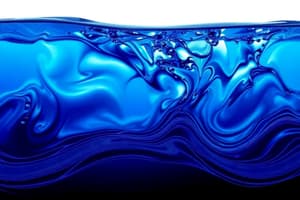Podcast
Questions and Answers
Which region of the turbulent boundary layer represents a very small portion?
Which region of the turbulent boundary layer represents a very small portion?
- Buffer layer
- Transition layer
- Turbulent layer
- Viscous (or laminar) sublayer (correct)
What percentage of the turbulent boundary layer does the buffer layer represent?
What percentage of the turbulent boundary layer does the buffer layer represent?
- ~15% (correct)
- ~85%
- ~50%
- ~30%
What is used as a substitute for TW wall temperature in practical problems?
What is used as a substitute for TW wall temperature in practical problems?
- Fluid properties
- Nusselt number
- Constant wall heat flux (q″) (correct)
- Film temperature (Tf)
What happens if the plate is long enough in terms of the laminar portion?
What happens if the plate is long enough in terms of the laminar portion?
Where does transition typically occur in the turbulent boundary layer?
Where does transition typically occur in the turbulent boundary layer?
What is used to evaluate fluid properties in calculations unless otherwise noted?
What is used to evaluate fluid properties in calculations unless otherwise noted?
Which region of the turbulent boundary layer represents approximately 85%?
Which region of the turbulent boundary layer represents approximately 85%?
What range does transition typically occur within?
What range does transition typically occur within?
Which equation is solved for the constant wall heat flux problem?
Which equation is solved for the constant wall heat flux problem?
What is assumed about the fluid in the analysis of boundary layer flow?
What is assumed about the fluid in the analysis of boundary layer flow?
In the force balance on the elemental control volume, which direction are viscous-shear forces assumed to be negligible?
In the force balance on the elemental control volume, which direction are viscous-shear forces assumed to be negligible?
What does the momentum flux in the x direction represent for the control volume?
What does the momentum flux in the x direction represent for the control volume?
What assumption is made regarding the depth in the z-direction within the control volume?
What assumption is made regarding the depth in the z-direction within the control volume?
In fluid dynamics, why is it not convenient to work with elements of mass?
In fluid dynamics, why is it not convenient to work with elements of mass?
Which assumption is made about pressure variations in relation to the plate direction?
Which assumption is made about pressure variations in relation to the plate direction?
Why are viscous-shear forces assumed to be negligible in the y direction for boundary layer analysis?
Why are viscous-shear forces assumed to be negligible in the y direction for boundary layer analysis?
Flashcards are hidden until you start studying
Study Notes
Boundary Layer Flow
- The boundary layer flow on a flat plate can be divided into two regimes: laminar and turbulent flow.
- Initially, the boundary-layer development is laminar, but at some critical distance from the leading edge, the flow becomes turbulent due to small disturbances in the flow.
- The transition from laminar to turbulent flow occurs when the Reynolds number, a dimensionless grouping of terms, is used as a criterion.
Laminar Velocity Profile
- The laminar velocity profile on a flat plate can be pictured as a random churning action with chunks of fluid moving to and fro in all directions.
- The equation of motion for the boundary layer can be derived by making a force-and-momentum balance on an elemental control volume.
Assumptions
- To simplify the analysis, assumptions are made:
- The fluid is incompressible and the flow is steady.
- There are no pressure variations in the direction perpendicular to the plate.
- The viscosity is constant.
- Viscous-shear forces in the y direction are negligible.
Momentum Flux and Force Balance
- The momentum flux in the x direction is the product of the mass flow through a particular side of the control volume and the x component of velocity at that point.
- The mass entering the left face of the element per unit time is calculated by applying Newton's second law of motion.
Prandtl Number and Heat Transfer
- The Prandtl number is a dimensionless group that represents the ratio of the transport coefficient for viscous momentum transport to the transport coefficient for heat conduction.
- When the Prandtl number is large, the ability of the fluid to transport momentum is greater than that to transport thermal energy.
- For Pr = 1, the equation of energy is similar to the equation of motion, and the dimensionless velocity profile solution is the same as the dimensionless temperature profile solution.
Turbulent Flow over a Flat Plate
- As the boundary layer thickens, turbulence appears, characterized by a sudden rapid increase in the thickness of the boundary layer.
- The turbulent boundary layer is divided into three regions: the viscous (or laminar) sublayer, the buffer layer, and the turbulent layer.
- For purposes of calculation, transition is assumed to occur at Rex= 5x10^5.
Procedure for Calculations
- Identify the flow geometry (flow over flat plate, cylinder, or sphere, or flow through pipe).
- Evaluate fluid properties at film temperature Tf = (Tw + T∞)/2 unless otherwise noted.
- Calculate Reynolds number and determine whether the flow is laminar or turbulent.
Studying That Suits You
Use AI to generate personalized quizzes and flashcards to suit your learning preferences.




